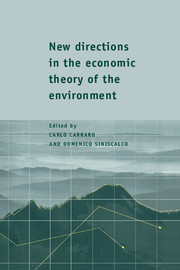Book contents
- Frontmatter
- Contents
- List of contributors
- 1 Theoretical frontiers of environmental economics
- 2 Growth with natural and environmental resources
- 3 Environmental policy and technological innovation
- 4 Environmental policy, distortionary labour taxation and employment: pollution taxes and the double dividend
- 5 International coordination of environmental taxes
- 6 Environmental policy and international trade
- 7 Environmental regulation and international capital allocation
- 8 Towards a theory of international environmental cooperation
- 9 Group formation in games without spillovers
- 10 Non-cooperative models of coalition formation in games with spillovers
- Index
3 - Environmental policy and technological innovation
Published online by Cambridge University Press: 11 January 2010
- Frontmatter
- Contents
- List of contributors
- 1 Theoretical frontiers of environmental economics
- 2 Growth with natural and environmental resources
- 3 Environmental policy and technological innovation
- 4 Environmental policy, distortionary labour taxation and employment: pollution taxes and the double dividend
- 5 International coordination of environmental taxes
- 6 Environmental policy and international trade
- 7 Environmental regulation and international capital allocation
- 8 Towards a theory of international environmental cooperation
- 9 Group formation in games without spillovers
- 10 Non-cooperative models of coalition formation in games with spillovers
- Index
Summary
Introduction
There has been a very considerable surge of interest in recent years on the question of how various types of environmental policy will affect incentives to innovate. There have been two main strands of concern underpinning this work.
The first is prompted by the concern that environmental policies operate by correcting the distortions introduced by having unpriced externalities. Since the major externalities of concern arise from pollution, this typically means that when goods and services are traded at their true price they become more expensive, leading to a reduction in output of those activities and a re-allocation to others. While this is precisely what these policies are intended to achieve, the question arises as to whether the amount of re-allocation might be reduced if the introduction of such policies spurred firms to innovate in order to discover new cleaner technologies which had lower levels of emissions. The question therefore arises as to just how effective environmental policies are in generating new innovation.
Early work on this question by, for example, Downing and White (1986) Magat (1979), Malueg (1989) and Milliman and Prince (1989), explored the effectiveness of a number of different environmental policies. However this literature suffered from a number of weaknesses. The focus was purely on the polluting activities of firms, and the interaction between this and the product market was poorly developed. Indeed the product market was typically taken to be perfectly competitive. Finally innovation was modelled as an activity taking place under perfect certainty and with full information.
- Type
- Chapter
- Information
- New Directions in the Economic Theory of the Environment , pp. 43 - 68Publisher: Cambridge University PressPrint publication year: 1997
- 14
- Cited by

